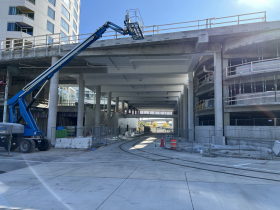Streetcar Extension Opens Sunday
And at least one GOP congressman is already trying to stop it.
The first extension of Milwaukee’s streetcar system opens Sunday, Oct. 29 at 7 a.m.
Known as the L Line, the lakefront extension of The Hop initially won’t operate like anyone planned when the 2.1-mile main line (M Line) opened in November 2018. Due to delays with the construction of a building through which it operates, service will first operate only on Sundays. Full daily service along the route is expected to begin in April 2024, when the lower half of the 44-story The Couture tower is completed and open to its first residents.
The extension includes three new stops: an eastbound stop at E. Michigan St. and N. Jackson St., a lakefront stop in the base of The Couture and a westbound stop at E. Clybourn St. and N. Jefferson St. The vehicle will proceed through The Couture initially, but will not stop in the building. It includes approximately 0.7 miles of new, one-way track.
In addition to the east-west lakefront extension, the L Line will use existing track and stations on N. Milwaukee Street and N. Broadway between E. Kilbourn and E. St. Paul avenues. The existing M Line will continue to serve the full 2.1-mile route.
Operating between 7 a.m. and 10 p.m., the L Line will operate with a 20-minute headway (frequency). The schedule of the M Line is being modified to accommodate the L Line, though the scheduled window in which service is provided will not change. Headways will be reduced (improved) from 20 minutes all day to 15 minutes between 11 a.m. and 7 p.m. on Saturdays. Monday through Thursday service will see headways increased after 8 p.m. to 20 minutes between trains, with the prior schedule not having the less frequent service until 10 p.m. Service will continue to be offered on the M Line from 5 a.m. to midnight on weekdays, Saturdays from 7 a.m. to midnight and 7 a.m. to 10 p.m. on Sundays.
“We are constantly examining our ridership data and exploring ways to better meet the needs of our passengers,” said Commissioner of Public Works Jerrel Kruschke in a statement Thursday. “We continue to see strong ridership numbers during peak hours, especially on weekends. This new schedule allows us to maintain all the service hours our riders count on, while providing more frequent service on Saturdays when the cars are busiest.”
The long-delayed and now one-day-a-week start can be traced back to delays with The Couture itself. The developers of the apartment tower struggled to secure financing, then encountered construction issues that extended the construction timeline by many months.
The extension was approved and funded alongside the initial route in 2015, with much of the track work completed alongside the base route’s 2018 opening. The Couture delays ultimately imperiled a 2015 federal grant for the line, requiring the city to seek an extension from Congress in 2022 on the $14.2 million grant.
The grant was scheduled to expire at the end of September 2022, but Congress granted a one-year extension. A revised development agreement for The Couture called for service to start by Oct. 31, 2023. Most of the line was completed prior to the M Line’s 2018 opening, but construction on The Couture didn’t begin until 2021 and then encountered delays. Kruschke, during an Oct. 11 media preview, didn’t deny that the grant was driving the unusual Sunday-only service start, but did say it would provide an opportunity for operator training.
Congressman Bryan Steil (R-Wisconsin), whose district does not include the system, is calling for the U.S. Department of Transportation to waive the grant requirement to start service given that the building isn’t completed and winter is approaching. “This is taxpayer money chasing taxpayer money chasing taxpayer money,” said Steil in an interview with WISN 12. “We can save Milwaukee thousands of taxpayer dollars.
The 2023 city budget calls for $4.9 million to be spent on operating the streetcar system. That expense is to be offset by $3.5 million in direct revenue, with the remainder coming from the city’s parking revenue. Direct revenue sources include Potawatomi Hotel & Casino ($833,333), other sponsors ($390,000), a federal pandemic-related transit grant ($2.1 million) and a federal transit support grant ($214,000).
Testing of the route has occurred this summer as a contracting team completed the guideway for the fixed-rail system. Much of the L Line will operate without an overhead wire, with the vehicles running on battery power. The $29.2 million route’s funding allocation was part of the original $128.1 million streetcar system.
Ridership has climbed year-over-year for 29 straight months. But that streak is imperiled by a factor outside of The Hop’s control. A late August water main break in the middle of the route shuttered the system, and closed a handful of nearby buildings, for approximately a week. Buses were used for a portion of the period. Ridership for data has yet to be posted.
Additional schedule information is available on The Hop website. It is easiest to find when the next streetcar will arrive by using the TransLoc smartphone application, which shows real-time vehicle location.
Video
Photos
Route Map
If you think stories like this are important, become a member of Urban Milwaukee and help support real, independent journalism. Plus you get some cool added benefits.
More about the Couture
- The Couture Names First Retail Tenant - Sophie Bolich - Jun 6th, 2025
- Streetcar Begins Daily Service To The Couture, BRT Will Soon Follow - Jeramey Jannene - Apr 11th, 2024
- Friday Photos: See The View From The Couture’s Upper Levels - Jeramey Jannene - Mar 8th, 2024
- The Couture Shows Off First Apartments - Jeramey Jannene - Jan 24th, 2024
- Transportation: Streetcar Extension Opens Sunday - Jeramey Jannene - Oct 28th, 2023
- Lakefront Streetcar Extension Opens October 29 - Jeramey Jannene - Aug 22nd, 2023
- Eyes on Milwaukee: See Inside The Couture’s Rise - Jeramey Jannene - Mar 9th, 2023
- Transportation: Congress Extends Streetcar Grant - Jeramey Jannene - Mar 16th, 2022
- Eyes on Milwaukee: The Couture Starts Massive Concrete Pour - Jeramey Jannene - Mar 16th, 2022
- City Hall: Council Could End Fight Over Couture Provision - Jeramey Jannene - Feb 22nd, 2022
Read more about Couture here
More about the Milwaukee Streetcar
For more project details, including the project timeline, financing, route and possible extensions, see our extensive past coverage.
- Another Streetcar Collision - Jeramey Jannene - Jun 27th, 2025
- Streetcar Hit By Apparent Red Light Runner - Jeramey Jannene - Jun 16th, 2025
- Streetcar Will Run On Consolidated Route During Summerfest - Jeramey Jannene - Jun 11th, 2025
- City Hall: Milwaukee Must Replace Failing Streetcar Switches - Jeramey Jannene - Feb 24th, 2025
- Streetcar Confronts Limited Funding, Operations Challenges - Evan Casey - Jan 22nd, 2025
- Council Kills Streetcar’s ‘Festivals Line’ - Jeramey Jannene - Jul 31st, 2024
- Streetcar Will Use Festivals-Oriented Route Through Summer - Jeramey Jannene - Jul 9th, 2024
- The Hop’s Lines Will Merge For Easier Summerfest Service - Jeramey Jannene - May 30th, 2024
- Streetcar Begins Daily Service To The Couture, BRT Will Soon Follow - Jeramey Jannene - Apr 11th, 2024
- Milwaukee’s Three Streetcar Extensions Need Mayoral Direction - Jeramey Jannene - Nov 8th, 2023
Read more about Milwaukee Streetcar here
Transportation
-
MCTS Adds 28 New Buses
 Jul 13th, 2024 by Graham Kilmer
Jul 13th, 2024 by Graham Kilmer
-
MCTS Designing New Bus Shelters
 Jul 10th, 2024 by Graham Kilmer
Jul 10th, 2024 by Graham Kilmer
-
MCTS Updates RNC Bus Detours To Better Serve Downtown, Riders
 Jul 9th, 2024 by Jeramey Jannene
Jul 9th, 2024 by Jeramey Jannene






























/i love the hop and take it as often as i can. however, it has never really made sense to me as rapid transportation as a subway and el. the hop, especially now that the extension is delayed because of couture building, feels elitist and snobby. i guess it has always been thought of as an attraction and not really going anyplace for most of the city.
I agree with (1) tornado75.
I take it if/when it coincides with my needs.
Otherwise it’s just a leisurely, frivolous recreational/touring vehicle
with nice big windows.
The Hop has accomplished much in demonstrating its potential during the past five years despite significant and relentless political opposition and general misunderstanding of the role and advantages of streetcars. I discuss the accomplishments of The Hop, which I break into six main areas, with the second area consisting of five parts: https://johndecember.com/places/mke/streetcar/threeyearsoftransit.html#experiencedaccomplishments
The $1.7 billion of development that has occurred so far along the route of the HOP is reason enough for its existence. Think of how much more property taxes the city gets.
To validate claims of development spurred by the Hop,
would require 1st checking the pace of development along the route
1, 3, 5, and 10 years prior, compared to the pace at the start of service
& to date. Then do the same for 1, 2, 3,-or more- streets parallel to the route.
Then check 10-year transit rider statistics for downtown in general.
(Despite the distance of platforms from nearby bus routes,
the zigzag path of the Hop sometimes makes it an attractive
‘happenstantial’ connector or alternate route.)
Check other factors for development such as US urban economies’ health in general, our demographics, infrastructure capacity, tax incentives, development curves of nearby entertainment venues, convention facilities, lodging, parking and more. Then you will have a better picture of how much credit to give to the Hop.
And last but not least compare the Hop’s construction, equipment and infrastructure relocation costs – total – to those of expanding bus service
to the same passenger-carrying capacity.
The truth’s puzzle here has many pieces!
You may find that the Hop is just a sweeter, pricier entrée
on an already substantial menu.
I rode it today to help keep those numbers up (though didn’t go through the doors on any L-Line / Johnson Controls stops, so net new effect is nil.
Thanks for including more background in this actual journalism than WISN 12 did about Bryan Steil’s manufactured opposition — they ended with his quote as the last thing anyone would read.
Get the Northern extension built already. Ridership will increase with equity.